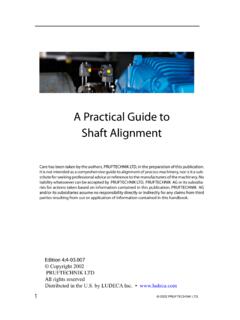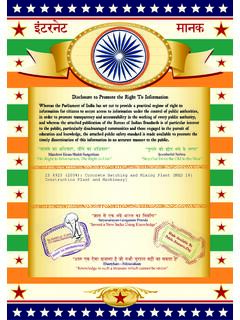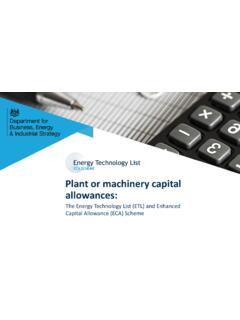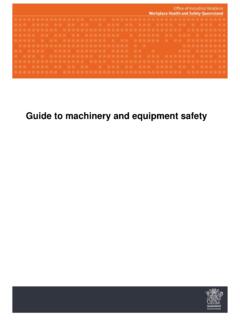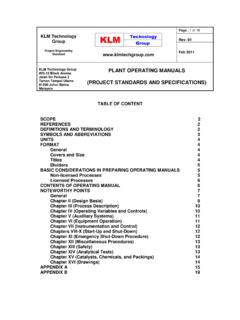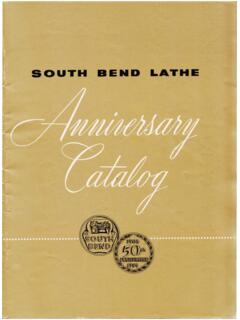Transcription of CHAPTER 10 PROPERTY, PLANT, AND EQUIPMENT
1 DOE Financial Management Handbook August 2013. CHAPTER 10. PROPERTY, PLANT, AND EQUIPMENT . 1. INTRODUCTION. a. Background/Authorities. This CHAPTER describes financial controls over the acquisition, use, and retirement of property and provides guidelines for distinguishing between charges to capital accounts and charges to expense accounts consistent with the Statement of Federal Financial Accounting Standards (SFFAS). b. Applicability. The applicability of this CHAPTER is specified in CHAPTER 1, Accounting Overview. When in conflict with the provisions of this paragraph, power marketing administrations (PMAs) should observe the policies of the Federal Energy Regulatory Commission and other industry standards as they apply to the accounting and financial management of property, plant, and EQUIPMENT (PP&E). c. Policy/Objectives. Financial accounting for PP&E should be governed by the following basic principles: (1) Department of Energy (DOE) property should be accounted for and reflected in the official DOE financial records in accordance with the capitalization criteria contained in this CHAPTER , regardless of funding source.
2 (2) Depreciation should be calculated and recorded in the appropriate cost-of-operation account, using the appropriate fund type;. (3) Timely and accurate financial reporting on facility construction and capital EQUIPMENT activities should be provided to DOE. management;. (4) Financial control over property should be maintained;. (5) The primary basis of accounting for property is its acquisition cost (with the general exceptions of transfers, excess property received, foreclosures, and discoveries); and (6) Common-use temporary construction facilities and EQUIPMENT should be budgeted for by the Landlord Program without chargeback to the benefiting construction projects. CHAPTER 10-1. d. Capitalization Criteria. (1) Capitalization Threshold. The capitalization threshold for items acquired prior to October 1, 2011 is $50,000. For items acquired on or after October 1, 2011, the threshold is $500,000.
3 (2) Capitalize individual PP&E items that are purchased, constructed, or fabricated in-house, including major modifications or improvements to any of these items, if they have an anticipated service life of 2 years or more and if they cost more than the capitalization threshold regardless of funding sources (see paragraph (a) below). The only exceptions are items that are inherently experimental, used as special tools, or, by nature of their association with a particular scientific experiment, not expected to have an extended useful service life or an alternative future use. Notwithstanding the accounting threshold for physical accountability/control purposes, personal property records are required for items of personal property with an acquisition cost of $5,000 or more. Data about real property, regardless of value, should be retained in the Facility Information Management System (FIMS) required per Title 41 CFR (a) Purchased Assets.
4 Generally, costs should be recorded net of purchase discounts taken. Purchase discounts lost and late-payment penalties should not be included as costs of assets, but should be written off as an operating expense. Capitalized cost includes all costs to convert or to make the facilities or EQUIPMENT ready for use, for example, invoice price, transportation, and installation costs. As a general rule, indirect costs associated with the purchase of the item are not capitalized. (b) Constructed Assets. When an entity constructs a depreciable asset for its own use, all direct costs are included in the total cost of the asset. Constructed capital assets must receive their allocable share of all indirect costs (CAS 404). (c) Purchased Asset Improvements. When the expenditures that increase the capacity or operating efficiency or extend the useful life of an asset are substantial, expenditures are capitalized.
5 Capitalized cost includes all costs to convert or to make the facilities or EQUIPMENT ready for use, for example, invoice price, transportation, and installation costs. DOE Financial Management Handbook August 2013. CHAPTER 10 Property, Plant, and EQUIPMENT Minor expenditures usually are treated as period costs even though they may have the characteristics of capital expenditures. (3) For capitalization of automated data processing software, follow directions contained in a November 20, 2000 memorandum issued by the CFO. Apply the capitalization threshold in effect at the time the software is acquired or completed. (4) Capitalize and group in a separate asset-type account related items that individually cost less than the capitalization threshold but that collectively cost more than the capitalization threshold, such as the initial complement of EQUIPMENT (for example, office EQUIPMENT ). for a building, if current costs would be distorted in a given period by charging such items to expense accounts.
6 The initial complement of EQUIPMENT of insignificant value relative to total project cost is generally distributed over the cost of the property record units to which it is related. (5) Capitalize property, including assets acquired through installment contracts and lease purchases, as described in this CHAPTER . (6) Generally, DOE elements should not capitalize interest during the acquisition of PP&E. However, certain DOE elements fund the acquisition, construction, or fabrication of PP&E through direct borrowing from the Department of the Treasury (Treasury) and pay interest directly to Treasury. In such cases, capitalize interest, if it is material, based on the interest rate charged by Treasury for the funds borrowed. The interest capitalization begins with the first expenditure for the qualifying asset and ends when the asset is substantially complete and ready for its intended use. Capitalize interest costs as long as the following general conditions are met: (a) Expenditures for PP&E have been made, and (b) Activities that are necessary to get PP&E ready for its intended use are in progress.
7 E. Property Record Unit Concept. (1) Property record units are designed to establish divisions of the completed PP&E categories. Property record units facilitate the recording of changes to property categories and the reconciliation of physical inventories with financial accounts. CHAPTER 10 - 3. DOE Financial Management Handbook August 2013. CHAPTER 10 Property, Plant, and EQUIPMENT (2) A property record unit, sometimes called a PP&E record unit, is a plant or EQUIPMENT item, for example, a building, selected to be continuously identified in the property records. The selection of property record units determines the manner in which costs are assembled and recorded in the property records. A property record unit may be composed of one or more retirement units. In selecting the property unit, consideration should be given to its use, relationship with other associated items, relative importance, frequency of anticipated property changes, and monetary value.
8 Generally, $50,000 or more is considered sufficient monetary value to justify maintaining continuing records of the property unit. A property record unit may be a functional unit consisting of an assembly of associated items, some of which are retirement units, such as a hydraulic extrusion press; a facility serving or designed to serve two or more other property record units, such as a control system or piping system; a continuous facility of which sections are retirement units, such as roads, walks, and paved areas; or a unit that is complete in itself, such as a spectrometer. (3) Retirement units are established for convenience in accounting for the replacements of major components of plant and EQUIPMENT . (a) A retirement unit establishes a physical dividing line by which costs of major work related to plant and EQUIPMENT are capitalized. Costs to extend the life of or replace the retirement unit should be capitalized.
9 All other costs related to the retirement unit should be expensed. A. retirement unit is a component of plant and EQUIPMENT that is capitalized in a separate account and invariably eliminated from the plant and EQUIPMENT accounts when removed, transferred, sold, abandoned, or demolished. (b) There should be a close coordination among the budget, accounting, engineering, project management, and technical staffs in the development and maintenance of retirement units. The development of retirement units should take into consideration such factors as use made of the item, retirement history of identical or comparable items, and the monetary and physical relationship of the item to the associated property record unit. Although items identified as retirement units are capitalized in the accounting records, from a budgeting perspective, the substitution of a new retirement unit of essentially the same type and performance capabilities as the replaced retirement unit should be funded out of operating funds.
10 CHAPTER 10 - 4. DOE Financial Management Handbook August 2013. CHAPTER 10 Property, Plant, and EQUIPMENT However, the substitution of a new retirement unit having significantly improved and superior performance capabilities beyond those of the replaced retirement unit is considered betterment and should be funded out of capital funds. (4) Each field element or integrated contractor will develop and maintain its own property record unit catalog or one that may serve all activities reporting to that element. Approval by the head of the field element or a designee is necessary for new catalogs and revisions of sections of existing catalogs. DOE review and approval of property record unit additions and deletions by contractors should be done annually by the cognizant field Chief Financial Officer (field CFO). A property record unit catalog describes the property record units that DOE owns. It provides a basis for a common understanding as to the manner in which PP&E.











